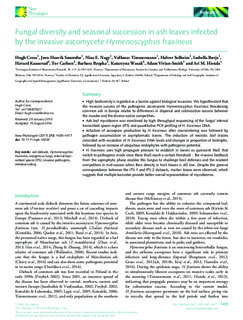| dc.contributor.author | Cross, Hugh | |
| dc.contributor.author | Sønstebø, Jørn Henrik | |
| dc.contributor.author | Nagy, Nina Elisabeth | |
| dc.contributor.author | Timmermann, Volkmar | |
| dc.contributor.author | Solheim, Halvor | |
| dc.contributor.author | Børja, Isabella | |
| dc.contributor.author | Kauserud, Håvard | |
| dc.contributor.author | Carlsen, Tor | |
| dc.contributor.author | Rzepka, Barbara | |
| dc.contributor.author | Wasak, Katarzyna | |
| dc.contributor.author | Vivian-Smith, Adam | |
| dc.contributor.author | Hietala, Ari Mikko | |
| dc.date.accessioned | 2017-11-22T21:19:47Z | |
| dc.date.available | 2017-11-22T21:19:47Z | |
| dc.date.created | 2016-09-29T10:54:45Z | |
| dc.date.issued | 2017-01-12 | |
| dc.identifier.citation | New Phytologist. 2017, 213 (3), 1405-1417. | nb_NO |
| dc.identifier.issn | 0028-646X | |
| dc.identifier.uri | http://hdl.handle.net/11250/2467657 | |
| dc.description.abstract | High biodiversity is regarded as a barrier against biological invasions. We hypothesized that the invasion success of the pathogenic ascomycete Hymenoscyphus fraxineus threatening common ash in Europe relates to differences in dispersal and colonization success between the invader and the diverse native competitors. Ash leaf mycobiome was monitored by high-throughput sequencing of the fungal internal transcribed spacer region (ITS) and quantitative PCR profiling of H. fraxineus DNA. Initiation of ascospore production by H. fraxineus after overwintering was followed by pathogen accumulation in asymptomatic leaves. The induction of necrotic leaf lesions coincided with escalation of H. fraxineus DNA levels and changes in proportion of biotrophs, followed by an increase of ubiquitous endophytes with pathogenic potential. H. fraxineus uses high propagule pressure to establish in leaves as quiescent thalli that switch to pathogenic mode once these thalli reach a certain threshold – the massive feedback from the saprophytic phase enables this fungus to challenge host defenses and the resident competitors in mid-season when their density in host tissues is still low. Despite the general correspondence between the ITS-1 and ITS-2 datasets, marker biases were observed, which suggests that multiple barcodes provide better overall representation of mycobiomes. | nb_NO |
| dc.language.iso | eng | nb_NO |
| dc.publisher | New Phytologist Trust | nb_NO |
| dc.rights | Navngivelse 4.0 Internasjonal | * |
| dc.rights.uri | http://creativecommons.org/licenses/by/4.0/deed.no | * |
| dc.title | Fungal diversity and seasonal succession in ash leaves infected by the invasive ascomycete Hymenoscyphus fraxineus | nb_NO |
| dc.type | Journal article | nb_NO |
| dc.type | Peer reviewed | nb_NO |
| dc.description.version | publishedVersion | nb_NO |
| dc.rights.holder | © 2016 The Authors | nb_NO |
| dc.source.pagenumber | 1405-1417 | nb_NO |
| dc.source.volume | 213 | nb_NO |
| dc.source.journal | New Phytologist | nb_NO |
| dc.source.issue | 3 | nb_NO |
| dc.identifier.doi | 10.1111/nph.14204 | |
| dc.identifier.cristin | 1387335 | |
| dc.relation.project | Norges forskningsråd: 235947/E40 | nb_NO |
| dc.relation.project | Norges forskningsråd: 203822/ E40 | nb_NO |
| cristin.ispublished | true | |
| cristin.fulltext | original | |
| cristin.qualitycode | 2 | |

